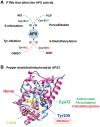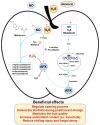Ascorbate peroxidase in fruits and modulation of its activity by reactive species
- PMID: 38442039
- PMCID: PMC11066807
- DOI: 10.1093/jxb/erae092
Ascorbate peroxidase in fruits and modulation of its activity by reactive species
Erratum in
-
Correction to: Ascorbate peroxidase in fruits and modulation of its activity by reactive species.J Exp Bot. 2024 May 20;75(10):3201. doi: 10.1093/jxb/erae142. J Exp Bot. 2024. PMID: 38574176 Free PMC article. No abstract available.
Abstract
Ascorbate peroxidase (APX) is one of the enzymes of the ascorbate-glutathione cycle and is the key enzyme that breaks down H2O2 with the aid of ascorbate as an electron source. APX is present in all photosynthetic eukaryotes from algae to higher plants and, at the cellular level, it is localized in all subcellular compartments where H2O2 is generated, including the apoplast, cytosol, plastids, mitochondria, and peroxisomes, either in soluble form or attached to the organelle membranes. APX activity can be modulated by various post-translational modifications including tyrosine nitration, S-nitrosation, persulfidation, and S-sulfenylation. This allows the connection of H2O2 metabolism with other relevant signaling molecules such as NO and H2S, thus building a complex coordination system. In both climacteric and non-climacteric fruits, APX plays a key role during the ripening process and during post-harvest, since it participates in the regulation of both H2O2 and ascorbate levels affecting fruit quality. Currently, the exogenous application of molecules such as NO, H2S, H2O2, and, more recently, melatonin is seen as a new alternative to maintain and extend the shelf life and quality of fruits because they can modulate APX activity as well as other antioxidant systems. Therefore, these molecules are being considered as new biotechnological tools to improve crop quality in the horticultural industry.
Keywords: S-nitrosation; Fruit ripening; hydrogen peroxide; melatonin; nitration; nitric oxide; pepper fruit; peroxynitrite; persulfidation; post-translational modifications.
© The Author(s) 2024. Published by Oxford University Press on behalf of the Society for Experimental Biology.
Conflict of interest statement
The authors declare no conflict of interest.
Figures





Similar articles
-
H2O2-generating polyamine oxidases (PAOs) are modulated during sweet pepper ripening: Spermine oxidase (SpmOX) as a case study of post-translational modification regulation.Plant Sci. 2025 Oct;359:112606. doi: 10.1016/j.plantsci.2025.112606. Epub 2025 Jun 11. Plant Sci. 2025. PMID: 40513896
-
Physiological function and regulation of ascorbate peroxidase isoforms.J Exp Bot. 2024 May 3;75(9):2700-2715. doi: 10.1093/jxb/erae061. J Exp Bot. 2024. PMID: 38367016 Review.
-
Systemic pharmacological treatments for chronic plaque psoriasis: a network meta-analysis.Cochrane Database Syst Rev. 2017 Dec 22;12(12):CD011535. doi: 10.1002/14651858.CD011535.pub2. Cochrane Database Syst Rev. 2017. Update in: Cochrane Database Syst Rev. 2020 Jan 9;1:CD011535. doi: 10.1002/14651858.CD011535.pub3. PMID: 29271481 Free PMC article. Updated.
-
Systemic pharmacological treatments for chronic plaque psoriasis: a network meta-analysis.Cochrane Database Syst Rev. 2021 Apr 19;4(4):CD011535. doi: 10.1002/14651858.CD011535.pub4. Cochrane Database Syst Rev. 2021. Update in: Cochrane Database Syst Rev. 2022 May 23;5:CD011535. doi: 10.1002/14651858.CD011535.pub5. PMID: 33871055 Free PMC article. Updated.
-
Signs and symptoms to determine if a patient presenting in primary care or hospital outpatient settings has COVID-19.Cochrane Database Syst Rev. 2022 May 20;5(5):CD013665. doi: 10.1002/14651858.CD013665.pub3. Cochrane Database Syst Rev. 2022. PMID: 35593186 Free PMC article.
Cited by
-
Genome-Wide Identification of APX Gene Family in Citrus maxima and Expression Analysis at Different Postharvest Preservation Times.Genes (Basel). 2024 Jul 12;15(7):911. doi: 10.3390/genes15070911. Genes (Basel). 2024. PMID: 39062690 Free PMC article.
-
Ascorbic acid metabolism and functions.J Exp Bot. 2024 May 3;75(9):2599-2603. doi: 10.1093/jxb/erae143. J Exp Bot. 2024. PMID: 38699987 Free PMC article.
-
Molecular and Physiological Responses of Plants that Enhance Cold Tolerance.Int J Mol Sci. 2025 Jan 29;26(3):1157. doi: 10.3390/ijms26031157. Int J Mol Sci. 2025. PMID: 39940925 Free PMC article. Review.
-
The overexpression of ascorbate peroxidase 2 (APX2) gene improves drought tolerance in maize.Mol Breed. 2025 Feb 15;45(2):27. doi: 10.1007/s11032-025-01548-2. eCollection 2025 Feb. Mol Breed. 2025. PMID: 39963376
-
Physiological and Microstructure Analysis Reveals the Mechanism by Which Formic Acid Delays Postharvest Physiological Deterioration of Cassava.Antioxidants (Basel). 2024 Oct 16;13(10):1245. doi: 10.3390/antiox13101245. Antioxidants (Basel). 2024. PMID: 39456497 Free PMC article.
References
-
- Aghdam MS, Luo Z, Li L, Jannatizadeh A, Fard JR, Pirzad F.. 2020. Melatonin treatment maintains nutraceutical properties of pomegranate fruits during cold storage. Food Chemistry 303, 125385. - PubMed
-
- Aghdam MS, Mahmoudi R, Razavi F, Rabiei V, Soleimani A.. 2018. Hydrogen sulfide treatment confers chilling tolerance in hawthorn fruit during cold storage by triggering endogenous H2S accumulation, enhancing antioxidant enzymes activity and promoting phenols accumulation. Scientia Horticulturae 238, 264–271.
-
- Aghdam MS, Mukherjee S, Flores FB, Arnao MB, Luo Z, Corpas FJ.. 2023. Functions of melatonin during postharvest of horticultural crops. Plant and Cell Physiology 63, 1764–1786. - PubMed
-
- Andrews PK, Fahy DA, Foyer CH.. 2004. Relationships between fruit exocarp antioxidants in the tomato (Lycopersicon esculentum) high pigment-1 mutant during development. Physiologia Plantarum 120, 519–528. - PubMed
-
- Arasimowicz-Jelonek M, Floryszak-Wieczorek J.. 2019. A physiological perspective on targets of nitration in NO-based signaling networks in plants. Journal of Experimental Botany 70, 4379–4389. - PubMed
Publication types
MeSH terms
Substances
Grants and funding
LinkOut - more resources
Full Text Sources
Miscellaneous

